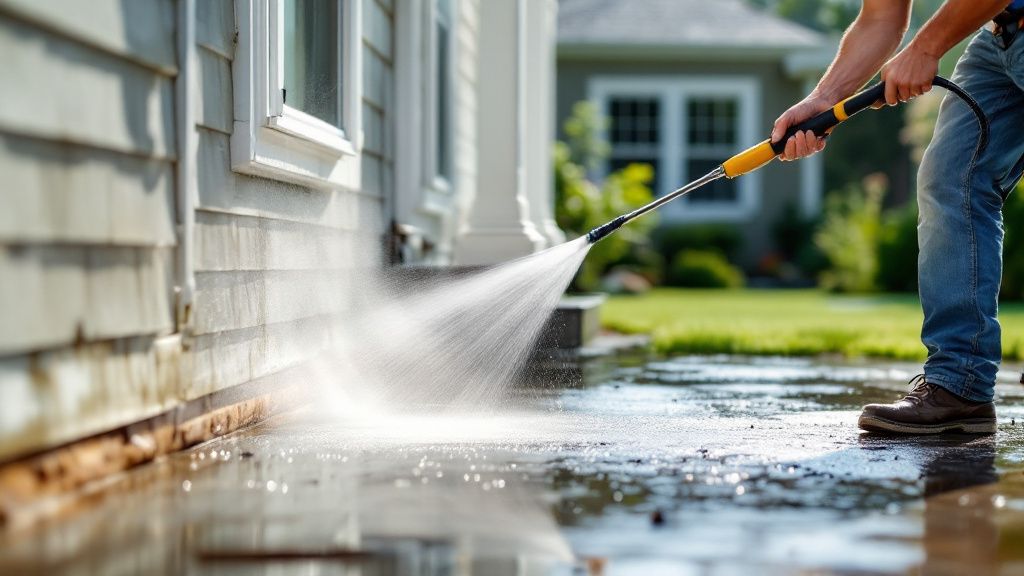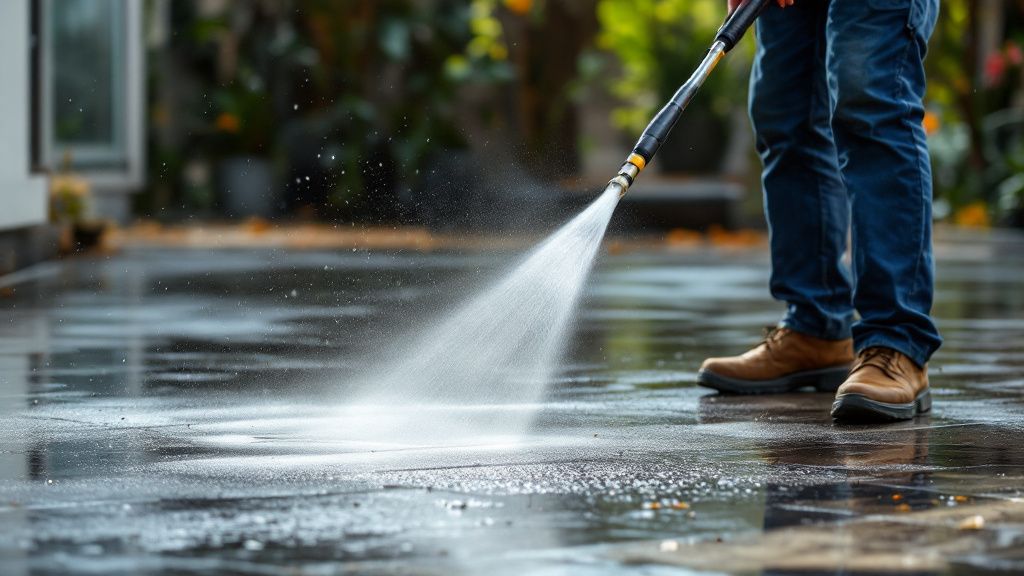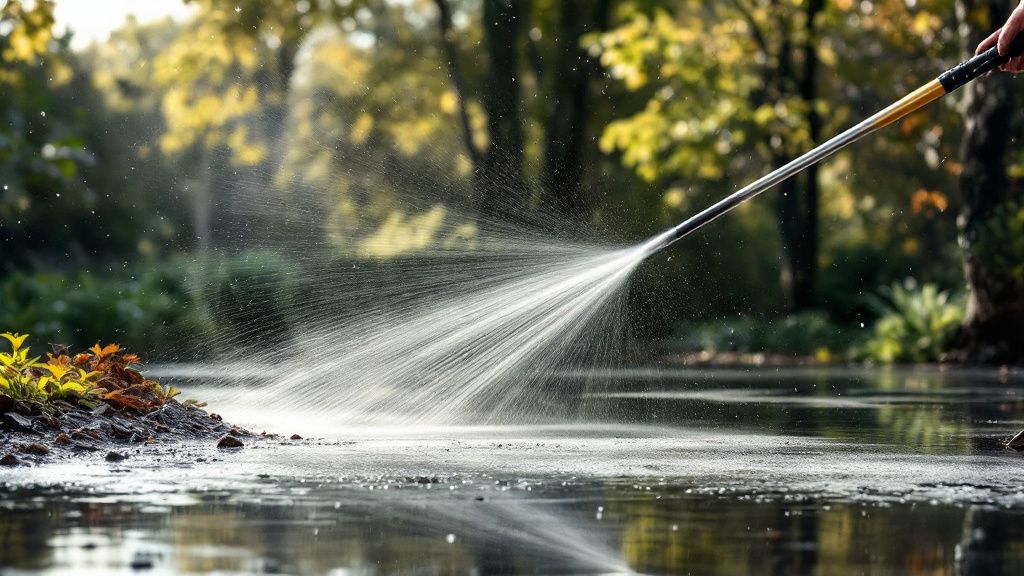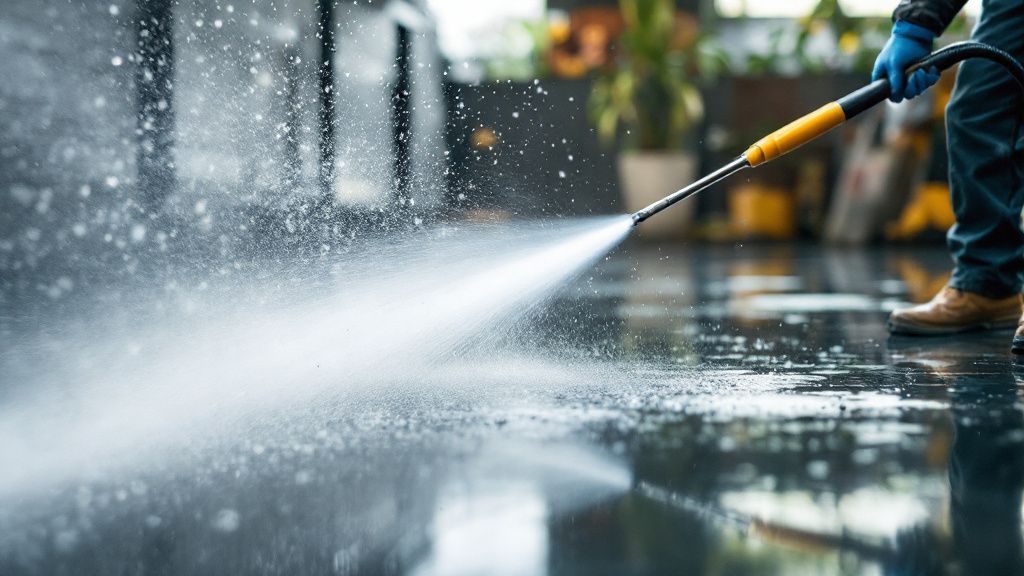In the realm of residential pressure washing, understanding how to avoid common errors is crucial for effective home maintenance. You might think it’s as simple as pointing and spraying, but improper power washing techniques can lead to damage and costly repairs. Selecting the right pressure washer and ensuring proper maintenance can prevent a host of issues. Using incorrect pressure washer settings or the wrong nozzle selection can result in surface damage or streaks, especially when cleaning house exteriors or delicate areas like windows. Pay attention to pressure washer safety tips to shield both yourself and your property from harm. Be mindful of the cleaning solutions and the effects of too high water pressure or incorrect water temperature. Time management during cleaning can also impact efficiency, while misuse of equipment may lead to unintended consequences. Proper storage of your pressure washer and having insurance can mitigate legal or financial setbacks. Balancing safety gear with correct device settings protects the integrity and beauty of your home, easing your pressure washing journey.
Understanding the Basics of Pressure Washing
Understanding the basics of pressure washing is essential to mastering this effective cleaning technique for your home. When beginning your journey in residential pressure washing, selecting the right pressure washer is crucial to achieving optimal results. You should be aware of the different nozzle selections that suit specific surfaces to avoid common errors in pressure washing, like streaks or surface damage.
Consider the story of the Thompson family who revitalized their driveway without professional help. Through meticulous research, they avoided pressure washer damage by choosing the right settings and cleaning solutions. This DIY pressure washing success not only preserved the aesthetic appeal of their property but also saved them considerable expenses.
Ensuring pressure washer maintenance is up to date prevents equipment misuse, keeping your device in top shape for when it’s needed. Adhering to pressure washer safety tips shields you from injury and circumvents costly repairs resulting from accidental damage during the pressure washing process.
Even in pressure washing, time management is vital. Proper planning allows you to tackle various tasks efficiently without exerting undue stress on your equipment. Avoiding pressure washing plant damage and managing water pressure issues ensures that your surfaces are left pristine and your greenery unharmed.
Mistake 1: Ignoring Surface Compatibility
A frequent error in residential pressure washing is overlooking the compatibility of surfaces, leading to potential damage and costly repairs. Certain materials, such as wood or older bricks, may not withstand the force commonly applied in pressure cleaning. To maximize efficiency while minimizing damage, it’s crucial to adjust water pressure and nozzle type according to the specific surface you intend to clean. Without taking these precautions, you risk causing unsightly streaks or even structural harm.
One of the challenges in pressure washing is managing pressure washing surface damage caused by incompatible settings. This issue can be addressed through careful selection of pressure washer settings, suited pressure washer cleaning solutions, and appropriate nozzle configurations for each surface type. For example, delicate surfaces like siding or deck materials need softer approaches to avoid pressure washing deck problems or siding errors. Following pressure washer safety tips and regular pressure washer maintenance can also prevent damage. Furthermore, dedicating time to learn about each surface’s cleaning requirements will eventually save you both time and money by avoiding irreparable harm.
Pressure washing mistakes can be reduced by ensuring that your pressure washer is not misused during DIY projects. Selecting the right pressure washer entails understanding its capabilities and limitations. Employing incorrect pressure washer settings can hamper your efforts, leading to further pressure washing surface damage. By maintaining awareness and applying careful techniques, you can protect your property while enjoying a clean, beautiful environment.
Mistake 2: Overlooking Environmental Factors
Ignoring environmental factors during residential pressure washing can lead to unforeseen problems that impact both your project and the surrounding area. Weather conditions, such as wind and rain, play a significant role in how your pressure washing attempts unfold. Overlooking these factors can exacerbate pressure washing mistakes, leading to uneven cleaning patterns, water wastage, or even transferring dirt to already cleaned sections.
Comparing outdoor temperature vs water temperature illustrates how varying conditions can affect the cleaning process. Cooler days might require adjustments in water temperature to maintain effectiveness, while high winds can cause pressure washer cleaning solutions to dissipate prematurely, reducing cleaning efficiency and causing streaks. Awareness and adaptation are crucial to avoid improper power washing techniques that stem from environmental oversight.
The location and surrounding nature are equally significant. Nearby plants are susceptible to pressure washing plants damage if not properly shielded during cleaning. Similarly, pressure cleaning house exteriors near gardens or lawns could result in disrupted landscaping. To prevent pressure washing equipment misuse, regular inspections and adjusting water pressure issues according to environmental conditions ensure that both the task and your immediate environment are protected.
Mistake 3: Using the Wrong Cleaning Solutions
Choosing the right cleaning solutions for residential pressure washing is vital for maintaining your home’s appearance and preventing damage. Using the wrong products can result in pressure washing surface damage, including discoloration and erosion. It’s essential to verify that the solutions are compatible with the surfaces you’re cleaning, whether they are decks, driveways, or siding, to avoid unnecessary pressure washing mistakes.
On one hand, some homeowners view generic, one-size-fits-all cleaning solutions as a cost-effective and convenient option for their entire property. They believe these products adequately address grime and buildup. On the other hand, there’s a strong argument for using specialized formulations tailored to specific materials, such as wood or concrete, which can enhance cleaning efficiency and minimize risk. This approach also supports optimal DIY pressure washing outcomes by lowering the potential for improper power washing techniques.
Selecting the wrong cleaning solution may also lead to safety issues and equipment misuse. Certain harsh chemicals can degrade pressure washer components, creating problems over time. To curb such issues, following pressure washer maintenance routines and using recommended cleaning agents preserve both machine longevity and the well-being of your surfaces.
Understanding the unique requirements of different areas, like avoiding streaks on windows or pressure cleaning house exteriors without harming nearby plants, sets the foundation for successful results. Incorporating pressure washer safety tips, such as choosing the right pressure washer settings and compatible solutions, ensures a smooth and effective pressure washing process.
Mistake 4: Skipping Pre-Cleaning Steps
Skipping pre-cleaning steps is a common oversight in residential pressure washing and contributes significantly to less effective cleaning results. Ensuring the area is prepared beforehand helps avoid improper power washing techniques and reduces the chances of pressure washing surface damage. Pre-cleaning steps may include removing debris, pre-treating stains, or covering delicate features to protect them during the washing process.
One unpopular opinion about residential pressure washing is that time spent on pre-cleaning actually reduces overall efficiency. While it might seem that directly tackling the grime saves time, neglecting these initial steps often results in prolonged cleaning sessions and sometimes necessitates a repeat effort due to inadequate preparation. Pressed by time constraints, individuals may miss crucial areas, leading to incomplete or uneven washes.
Not taking time to prepare surfaces can lead to equipment misuse, such as using the wrong pressure washer nozzle selection, causing undue strain on the pressure washing equipment. A preemptive look at your surroundings helps identify potential obstacles or sensitive areas, which will require specific attention to avoid unnecessary pressure washer hose problems or incorrect pressure washer settings.
Pressure washer maintenance and pressure washing safety tips suggest a cautious approach to ensure everything is set up correctly. Investing time in these preparatory steps can also help prevent more considerable mishaps, like lowering the risk of pressure cleaning driveway mistakes or pressure washing deck problems that arise from an unprepared environment.
Moreover, covering nearby plants and removing loose debris or outdoor furniture ensures the pressure washing process doesn’t inadvertently cause damage or create additional complications. Considering aspects like water pressure issues, proper safety gear, and potentially sensitive areas around the house makes the task both safer and more efficient. Skipping pre-cleaning may seem like a shortcut, but thorough preparation guarantees a smoother and more effective result.
Mistake 5: Incorrect Pressure Washer Handling
Incorrect pressure washer handling is a substantial issue in residential pressure washing, often leading to significant consequences, such as equipment misuse and surface damage. A key aspect of proper handling includes familiarizing yourself with the device and its manual, offering insights into correct pressure washer settings and maintenance. Attention to detail in handling ensures safe and effective cleaning while safeguarding the longevity of your equipment.
Looking at pressure washer handling through the lens of efficiency, we can see that a methodical approach is crucial. Taking the time to set up correctly, with the right nozzle selection and stable water pressure, not only enhances cleaning effectiveness but also minimizes the chance of pressure washing mistakes, such as streaks or structural harm. This perspective promotes a balanced focus on both task efficiency and care.
Additionally, wearing appropriate pressure washing safety gear shields you from potential hazards. Neglecting safety can lead to injury or respiratory issues, especially when dealing with strong cleaning solutions. Regularly reviewing pressure washer maintenance advice contributes to smoother operations, curtailing handling errors. Remember, improper power washing techniques are preventable with conscientious preparation, safeguarding your home against costly mishaps.





